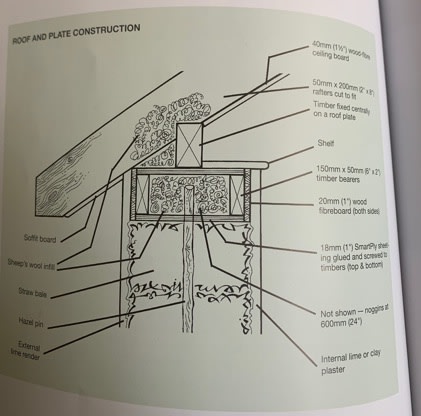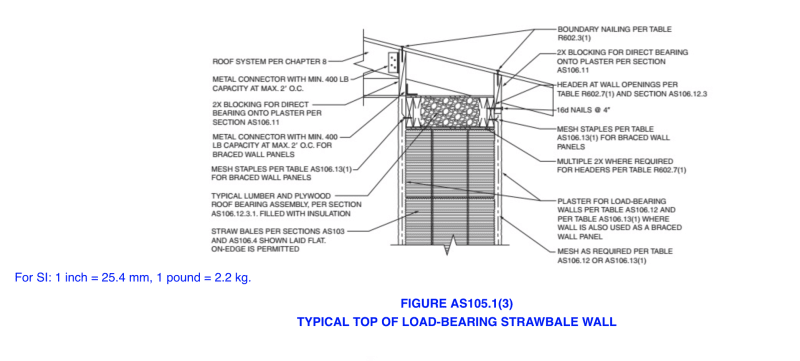Cam1985
Structural
- Jun 5, 2020
- 4
Here in India experimenting with Straw Bale building.
There are two separate instructions from different expert sectors in the field of straw bale construction. Here are diagrams showing the differences:


This building is challenging in that the plinth was built on top of a masonry tile floor, on top of compacted-earth, under the roof of a large and tall metal structure. I was involved after this plinth was all ready built, and walls were going up. The walls are built using the the load-bearing design method -- baseplate and roofplate/top plate compressing bales and reinforced with internal bamboo pinning.
Trying to design a roof that is lightweight enough to not overload the walls, but has enough weight to resist moderate wind speeds -- gusts likely no greater than 50-60 kmh, as this building is being built under the roof of another, larger structure, and is blocked from wind on two sides.
I would like to use a truss design that allows for switching out PUF panel insulation for bagged straw for testing purposes. I am thinking to have the trusses rest directly across the whole width of the top plate AND attach blocking on the inside and outside connecting plaster skin, roof system, top/roof plate.
Does the blocking need to contact the whole length-wise face of the top of the plaster skin? I cannot tell from the IBC Appendix S image "Typical Top of Load-Bearing Strawbale Wall" if the 2x blocking that connects the roof, plaster skin, and top plate also contacts plaster surfaces across the whole interval between roof rafter/truss elements? Thoughts?
Here is a designs I've modeled, please share your thoughts:

Can the blocking be a 2"x6" board birdsmouthed/notched like shown here?
Appreciate insights -- thank you.
There are two separate instructions from different expert sectors in the field of straw bale construction. Here are diagrams showing the differences:


This building is challenging in that the plinth was built on top of a masonry tile floor, on top of compacted-earth, under the roof of a large and tall metal structure. I was involved after this plinth was all ready built, and walls were going up. The walls are built using the the load-bearing design method -- baseplate and roofplate/top plate compressing bales and reinforced with internal bamboo pinning.
Trying to design a roof that is lightweight enough to not overload the walls, but has enough weight to resist moderate wind speeds -- gusts likely no greater than 50-60 kmh, as this building is being built under the roof of another, larger structure, and is blocked from wind on two sides.
I would like to use a truss design that allows for switching out PUF panel insulation for bagged straw for testing purposes. I am thinking to have the trusses rest directly across the whole width of the top plate AND attach blocking on the inside and outside connecting plaster skin, roof system, top/roof plate.
Does the blocking need to contact the whole length-wise face of the top of the plaster skin? I cannot tell from the IBC Appendix S image "Typical Top of Load-Bearing Strawbale Wall" if the 2x blocking that connects the roof, plaster skin, and top plate also contacts plaster surfaces across the whole interval between roof rafter/truss elements? Thoughts?
Here is a designs I've modeled, please share your thoughts:

Can the blocking be a 2"x6" board birdsmouthed/notched like shown here?
Appreciate insights -- thank you.




